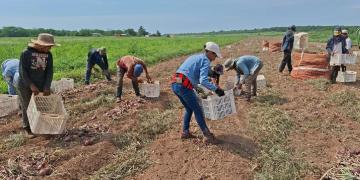Gran Bretaña: Managing Waste Potato Piles
Outgrade piles can be a source of blight. In this article we are discussing blight control methods in outgrade and waste piles as well as best practice and tips for tackling this issue.

Outgrade and waste piles - a source of blight
Blight control does not start in the crop. It starts much earlier. Left uncontrolled, outgrade and waste piles act as a reservoir for blight infection. With ever changing genotypes within the blight populations, outgrade piles and volunteers can be an unwanted host for blight and a source of infection for commercial crops. Infected plants produce millions of airborne spores which can travel for miles
Blight control methods in outgrade piles
Best practice is to adopt a zero tolerance approach to sprouting and production of green foliage on outgrade piles by tackling it early; preferably covering with black plastic sheeting. Covering the pile and ensuring the edges are sealed will prevent the escape of spores and reduce the likelihood of wind getting under the sheet. .
Where sheeting is not an option, any sprouted outgrades can be sprayed with glyphosate (read more resistance management advice) but this is high risk as work has shown that blight spores continue to be released during the slow haulm kill with this herbicide. Waste piles should also be kept low to increase any frost kill and reduce the risk of volunteers emerging from depth at a later day.
A further non-chemical option for smaller piles is to ‘flame weed’ using a weed control flame thrower. Flame weeding entails passing a flame over a weed briefly to heat the plant tissues just enough to kill them. The goal is not to burn up the weed, but to destroy plant tissue so that the weed dies. Flame weeding kills the above ground portion of the weed, but it doesn’t kill the roots. If you are planning to use flame weed method, please ensure you comply with current legislation.
Five tips to minimise effects of outgrade piles:
Stay vigilant and check regularly
Discuss your control strategy with your agronomist and aim for well-timed applications around a realistic risk-based blight control strategy
Minimise what goes into the outgrade pile.
Keep the outgrade pile low to increase any frost kill and reduce delayed emergence at depth.
Use black sheeting, as this is the best method to stop spores traveling
Potato outgrade control - best practice advice:
Outgrade piles should be accessible but well away from you and your neighbours’ next potato crops and farm buildings
Try to site piles on land not intended for any crop or any potato crop in the future
Don’t risk polluting watercourses - locate piles away from ditches, rivers, groundwater etc (read more about Waste management)
Left uncontrolled, even small outgrade piles can act as a reservoir for blight infection and may be a source of virus inoculum (read more about virus management)
Check with your neighbours, are they controlling their outgrade piles?
Keep checking outgrade piles throughout the season for re-growth
Fuente: https://ahdb.org.uk/news/managing-waste-potato-piles




